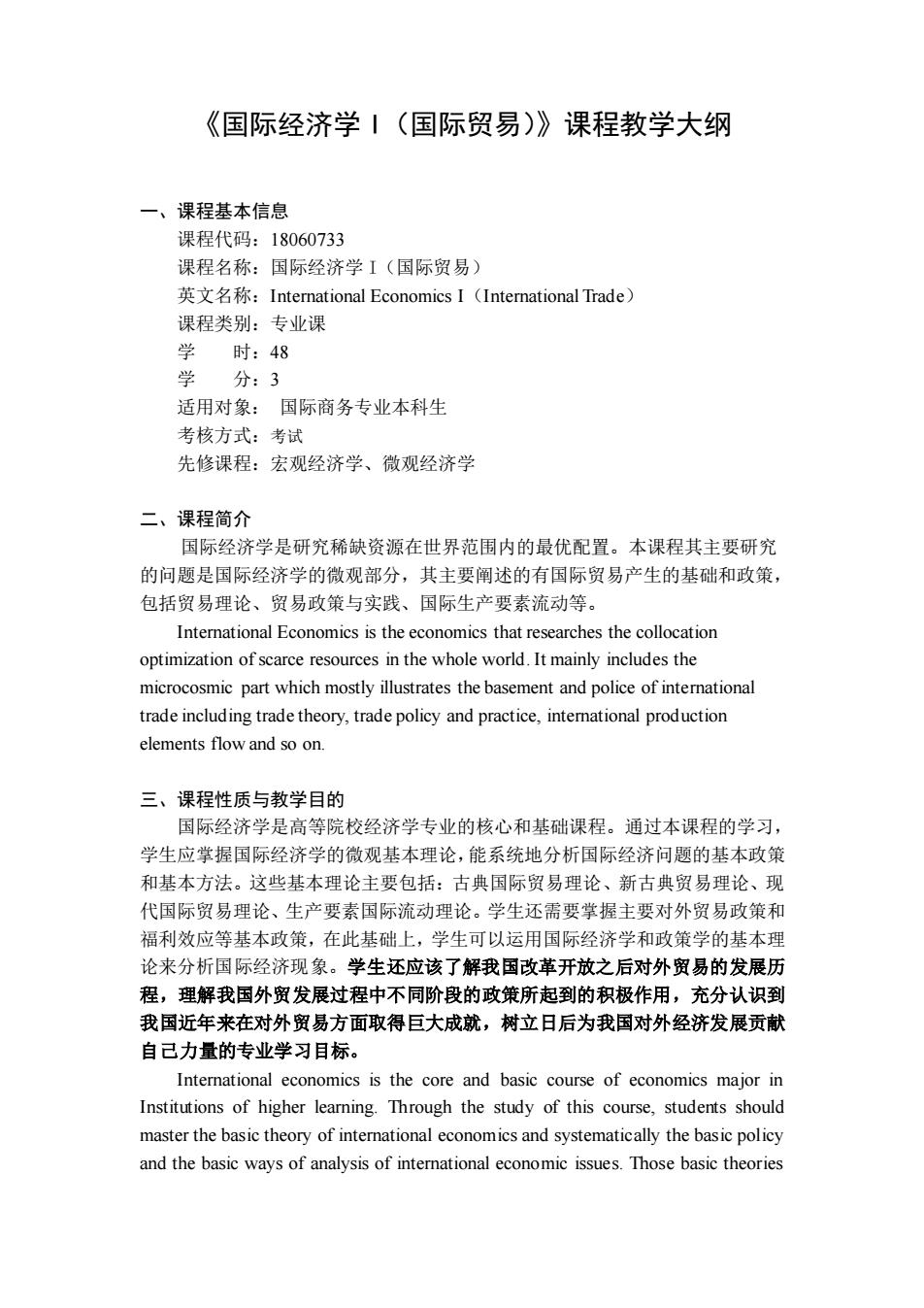
《国际经济学!(国际贸易)》课程教学大纲 一、课程基本信息 课程代码:18060733 课程名称:国际经济学I(国际贸易) 英文名称:International Economics I(International Trade) 课程类别:专业课 学 时:48 学分:3 适用对象:国际商务专业本科生 老核方式:考试 先修课程:宏观经济学、微观经济学 二、课程简介 国际经济学是研究稀缺资源在世界范围内的最优配置。本课程其主要研究 的问题是国际经济学的微观部分,其主要阐述的有国际贸易产生的基础和政策, 包括贸易理论、贸易政策与实践、国际生产要素流动等。 International Economics is the economics that researches the collocation optimization of scarce resources in the whole world.It mainly includes the microcosmic part which mostly illustrates the basement and police of interational trade including trade theory,tradepolicy and practiceintemational production elements flow and so on. 三、课程性质与教学目的 国际经济学是高等院校经济学专业的核心和基础课程。通过本课程的学习, 学生应掌握国际经济学的微观基本理论,能系统地分析国际经济问题的基本政策 和基本方法。这些基本理论主要包括:古典国际贸易理论、新古典贸易理论、现 代国际贸易理论、生产要素国际流动理论。学生还需要掌握主要对外贸易政策和 福利效应等基本政策,在此基础上,学生可以运用国际经济学和政策学的基本理 论来分析国际经济现象。学生还应该了解我国改革开放之后对外贸易的发展历 程,理解我国外贸发展过程中不同阶段的政策所起到的积极作用,充分认识到 我国近年来在对外贸易方面取得巨大成就,树立日后为我国对外经济发展贡献 自己力量的专业学习目标。 International economics is the core and basic course of economics major in Institutions of higher leamning.Through the study of this course.students should master the basic theory of intemational economics and systematically the basic policy and the basic ways of analysis of international economic issues.Those basic theories
《国际经济学 I(国际贸易)》课程教学大纲 一、课程基本信息 课程代码:18060733 课程名称:国际经济学 I(国际贸易) 英文名称:International Economics I(International Trade) 课程类别:专业课 学 时:48 学 分:3 适用对象: 国际商务专业本科生 考核方式:考试 先修课程:宏观经济学、微观经济学 二、课程简介 国际经济学是研究稀缺资源在世界范围内的最优配置。本课程其主要研究 的问题是国际经济学的微观部分,其主要阐述的有国际贸易产生的基础和政策, 包括贸易理论、贸易政策与实践、国际生产要素流动等。 International Economics is the economics that researches the collocation optimization of scarce resources in the whole world. It mainly includes the microcosmic part which mostly illustrates the basement and police of international trade including trade theory, trade policy and practice, international production elements flow and so on. 三、课程性质与教学目的 国际经济学是高等院校经济学专业的核心和基础课程。通过本课程的学习, 学生应掌握国际经济学的微观基本理论,能系统地分析国际经济问题的基本政策 和基本方法。这些基本理论主要包括:古典国际贸易理论、新古典贸易理论、现 代国际贸易理论、生产要素国际流动理论。学生还需要掌握主要对外贸易政策和 福利效应等基本政策,在此基础上,学生可以运用国际经济学和政策学的基本理 论来分析国际经济现象。学生还应该了解我国改革开放之后对外贸易的发展历 程,理解我国外贸发展过程中不同阶段的政策所起到的积极作用,充分认识到 我国近年来在对外贸易方面取得巨大成就,树立日后为我国对外经济发展贡献 自己力量的专业学习目标。 International economics is the core and basic course of economics major in Institutions of higher learning. Through the study of this course, students should master the basic theory of international economics and systematically the basic policy and the basic ways of analysis of international economic issues. Those basic theories
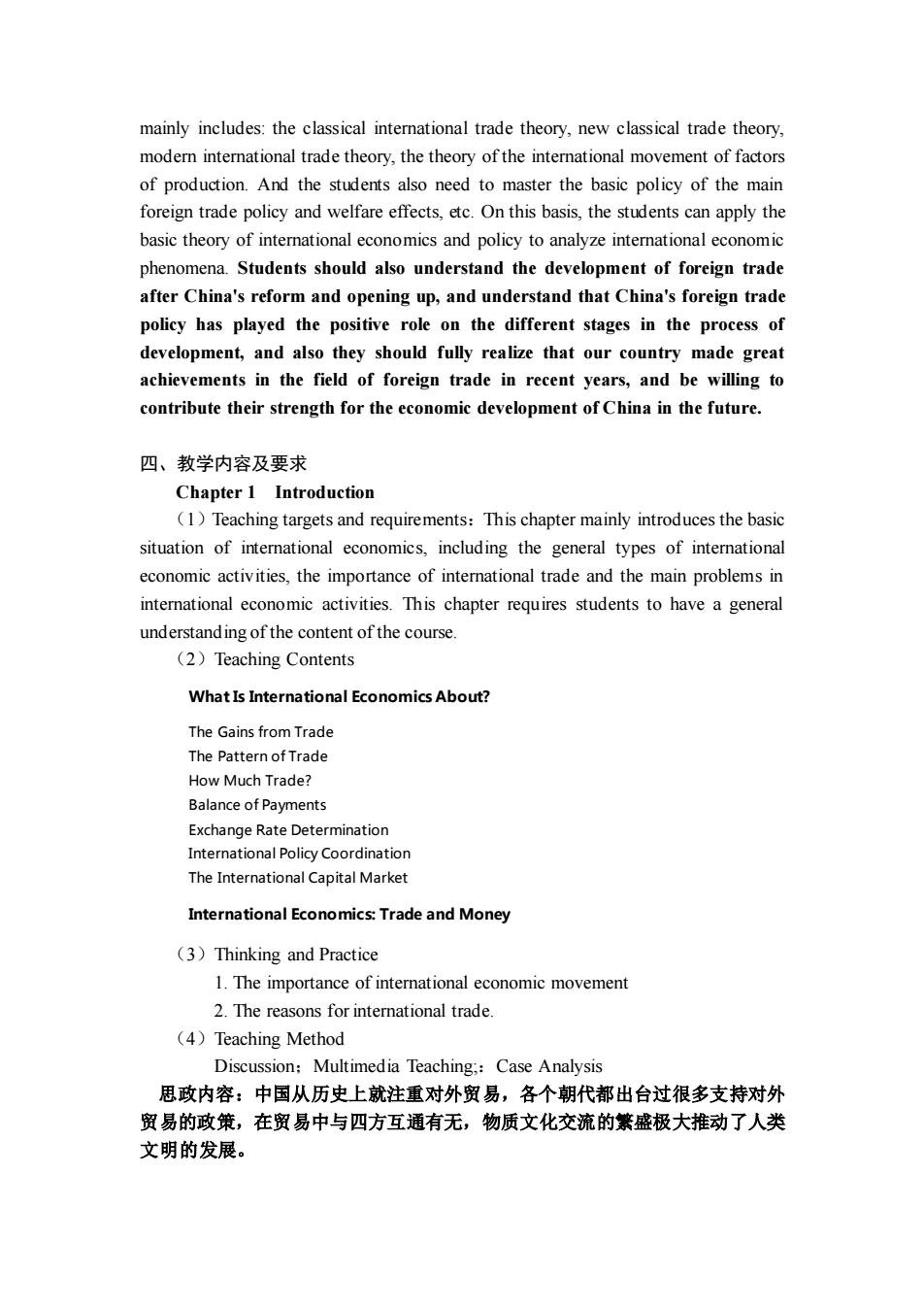
mainly includes:the classical intemational trade theory,new classical trade theory. modern intemational trade theory,the theory of the international movement of factors of production.And the students also need to master the basic policy of the main foreign trade policy and welfare effects,etc.On this basis,the students can apply the basic theory of intemational economics and policy to analyze intemational economic phenomena.Students should also understand the development of foreign trade after China's reform and opening up,and understand that China's foreign trade policy has played the positive role on the different stages in the process of development,and also they should fully realize that our country made great achievements in the field of foreign trade in recent years,and be willing to contribute their strength for the economic development of China in the future. 四、教学内容及要求 Chapter 1 Introduction (1)Teaching targets and requirements:This chapter mainly introduces the basic situation of interational economics,including the general types of international economic activities,the importance of international trade and the main problems in intemational economic activities.This chapter requires students to have a general understand ing of the content of the course (2)Teaching Contents What Is International Economics About? The Gains from Trade The pattern of Trade How Much Trade? International Policy Coordinatio The International Capital Market International Economics:Trade and Money (3)Thinking and Practice 1.The importance of interational economic movement 2.The reasons for international trade. 4)Teaching Method Discussion:Multimedia Teaching::Case Analysis 思政内容:中国从历史上就注重对外贸易,各个朝代都出台过很多支持对外 贸易的政策,在贸易中与四方互通有无,物质文化交流的繁盛极大推动了人类 文明的发展
mainly includes: the classical international trade theory, new classical trade theory, modern international trade theory, the theory of the international movement of factors of production. And the students also need to master the basic policy of the main foreign trade policy and welfare effects, etc. On this basis, the students can apply the basic theory of international economics and policy to analyze international economic phenomena. Students should also understand the development of foreign trade after China's reform and opening up, and understand that China's foreign trade policy has played the positive role on the different stages in the process of development, and also they should fully realize that our country made great achievements in the field of foreign trade in recent years, and be willing to contribute their strength for the economic development of China in the future. 四、教学内容及要求 Chapter 1 Introduction (1)Teaching targets and requirements:This chapter mainly introduces the basic situation of international economics, including the general types of international economic activities, the importance of international trade and the main problems in international economic activities. This chapter requires students to have a general understanding of the content of the course. (2)Teaching Contents What Is International Economics About? The Gains from Trade The Pattern of Trade How Much Trade? Balance of Payments Exchange Rate Determination International Policy Coordination The International Capital Market International Economics: Trade and Money (3)Thinking and Practice 1. The importance of international economic movement 2. The reasons for international trade. (4)Teaching Method Discussion;Multimedia Teaching;:Case Analysis 思政内容:中国从历史上就注重对外贸易,各个朝代都出台过很多支持对外 贸易的政策,在贸易中与四方互通有无,物质文化交流的繁盛极大推动了人类 文明的发展

Chapter 2 World Trade:An Overview (1 )Teaching targets and requirements:Describe how the value of trade between any two countries depends on the size of these countries'economies and explain the reasons for that relationshin discuss how distance and borders reduce trade describe how the share of intemational p roduction that is traded has fluct uated over time and why there have be n two ages of globalization.Explain how the mix of goodsan services that are traded intemationally has changed over time. (2)Teaching Contents Who Trades with Whom? Size Matters:The Gravity Model Using the Gravity Mo de:Looking for Anomalies Impediments to Trade:Distance,Barriers,and Borders The Changing Pattern of World Trade Has the world Gotten Smaller? What Do We Trade? Service Outsourcing Do Old Rules Still Apply? 3)Thinking and Practice 1 The main idea of The mercantilism 2.The main idea of The Gravity Model (4)Teaching Method Multimedia Teaching:Discussion 思政内容:介绍我国在当前国际贸易中的地位,展示说明我国改革开放以 来在对外贸易领域取得的巨大进步和辉煌成就,激发学生自信心和自豪感, Chapter 3 Labor Productivity and Comparative Advantage:The Ricardian Model (1)Teaching targets and requirements:Explain how the Ricardian model,the most basic model of i national I trade,works and how it illustrates the principle of comparative advantage.Demonstrate gainsfrom trade and refute common fallacies about intemational trade.Describe the empirical evidence that wages reflect productivity and that trade pattems reflect relative productivity. (2)Teaching Contents The Concept of Comparative Advantage A One-Factor Economy Production Possibilities
Chapter 2 World Trade: An Overview (1)Teaching targets and requirements:Describe how the value of trade between any two countries depends on the size of these countries’ economies and explain the reasons for that relationship. Discuss how distance and borders reduce trade. Describe how the share of international production that is traded has fluctuated over time and why there have been two ages of globalization. Explain how the mix of goods and services that are traded internationally has changed over time. (2)Teaching Contents Who Trades with Whom? Size Matters: The Gravity Model Using the Gravity Model: Looking for Anomalies Impediments to Trade: Distance, Barriers, and Borders The Changing Pattern of World Trade Has the World Gotten Smaller? What Do We Trade? Service Outsourcing Do Old Rules Still Apply? (3)Thinking and Practice 1. The main idea of The Mercantilism 2. The main idea of The Gravity Model (4)Teaching Method Multimedia Teaching;Discussion 思政内容:介绍我国在当前国际贸易中的地位,展示说明我国改革开放以 来在对外贸易领域取得的巨大进步和辉煌成就,激发学生自信心和自豪感。 Chapter 3 Labor Productivity and Comparative Advantage:The Ricardian Model (1)Teaching targets and requirements:Explain how the Ricardian model, the most basic model of international trade, works and how it illustrates the principle of comparative advantage. Demonstrate gains from trade and refute common fallacies about international trade. Describe the empirical evidence that wages reflect productivity and that trade patterns reflect relative productivity. (2)Teaching Contents The Concept of Comparative Advantage A One-Factor Economy Production Possibilities
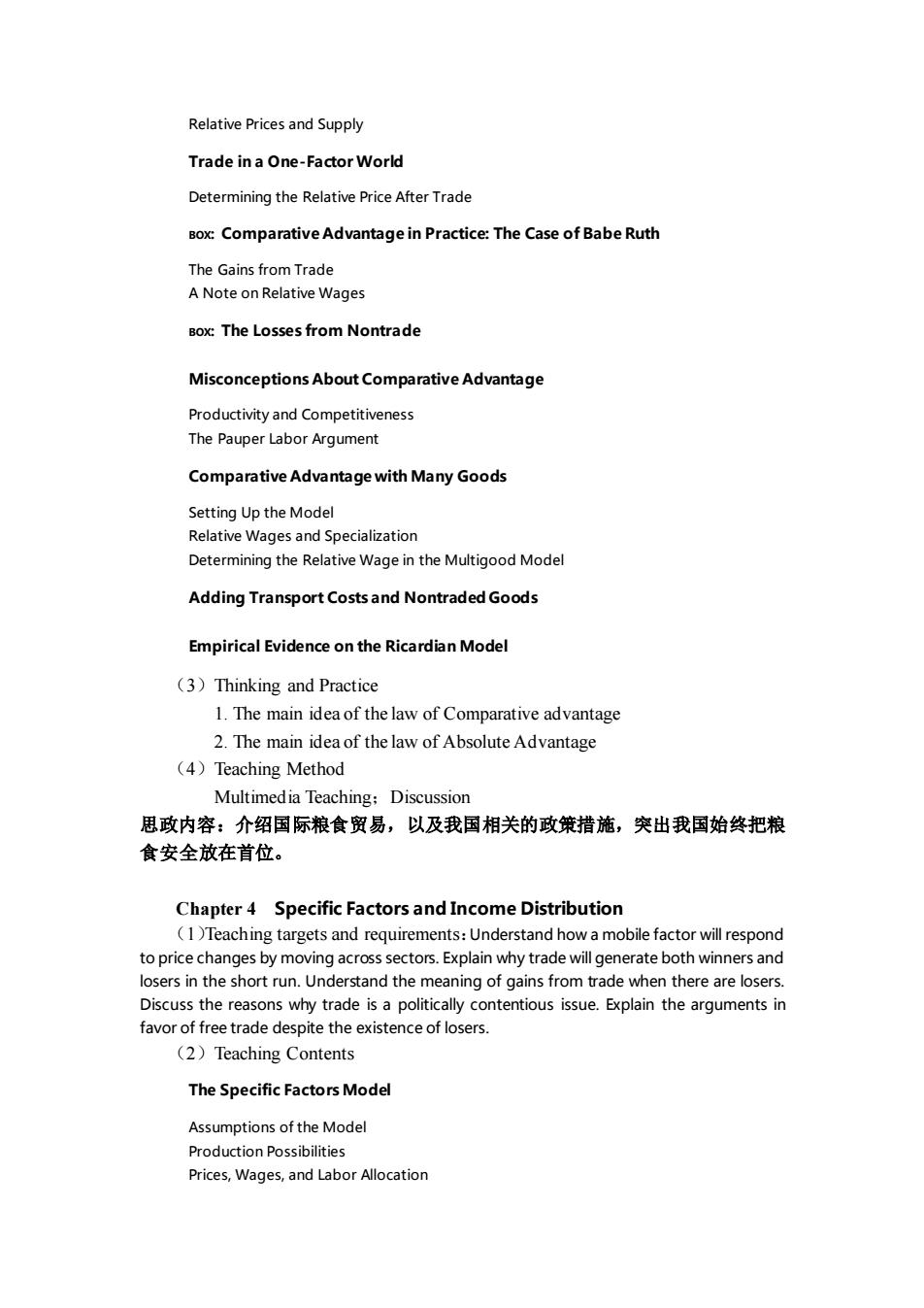
Relative Prices and Supply Trade in a One-Factor World Determining the Relative Price After Trade Box:Comparative Advantage in Practice:The Case of Babe Ruth The Gains from Trade A Note on Relative Wages Box:The Losses from Nontrade Misconceptions About Comparative Advantage Productivity and Competitiveness The Pauper Labor Argument Comparative Advantage with Many Goods Setting Up the Model Relative Wages and Specialization Determining the Relative Wage in the Multigood Model Adding Transport Costs and Nontraded Goods Empirical Evidence on the Ricardian Model (3)Thinking and Practice 1.The main idea of the law of Comparative advantage 2.The main idea of the law of Absolute Advantage (4)Teaching Method Multimedia Teaching:Discussion 思政内容:介绍国际粮食贸易,以及我国相关的政策措施,突出我国始终把粮 食安全放在首位。 Chapter 4 Specific Factors and Income Distribution (1)Teaching targets and requirements:Understand how a mobile factor will respond to price changes by moving across sectors.Explain why trade will generate both winners and losers in the short run.Understand the mean trade ng of gains from tr ade when there are losers. Discus e re ious issue.Expla h argument favor of free tra e despite the existence of losers (2)Teaching Contents The Specific Factors Model Assumptions of the Model Produ Prices,Wages,and Labor Allocation
Relative Prices and Supply Trade in a One-Factor World Determining the Relative Price After Trade BOX: Comparative Advantage in Practice: The Case of Babe Ruth The Gains from Trade A Note on Relative Wages BOX: The Losses from Nontrade Misconceptions About Comparative Advantage Productivity and Competitiveness The Pauper Labor Argument Comparative Advantage with Many Goods Setting Up the Model Relative Wages and Specialization Determining the Relative Wage in the Multigood Model Adding Transport Costs and Nontraded Goods Empirical Evidence on the Ricardian Model (3)Thinking and Practice 1. The main idea of the law of Comparative advantage 2. The main idea of the law of Absolute Advantage (4)Teaching Method Multimedia Teaching;Discussion 思政内容:介绍国际粮食贸易,以及我国相关的政策措施,突出我国始终把粮 食安全放在首位。 Chapter 4 Specific Factors and Income Distribution (1)Teaching targets and requirements:Understand how a mobile factor will respond to price changes by moving across sectors. Explain why trade will generate both winners and losers in the short run. Understand the meaning of gains from trade when there are losers. Discuss the reasons why trade is a politically contentious issue. Explain the arguments in favor of free trade despite the existence of losers. (2)Teaching Contents The Specific Factors Model Assumptions of the Model Production Possibilities Prices, Wages, and Labor Allocation
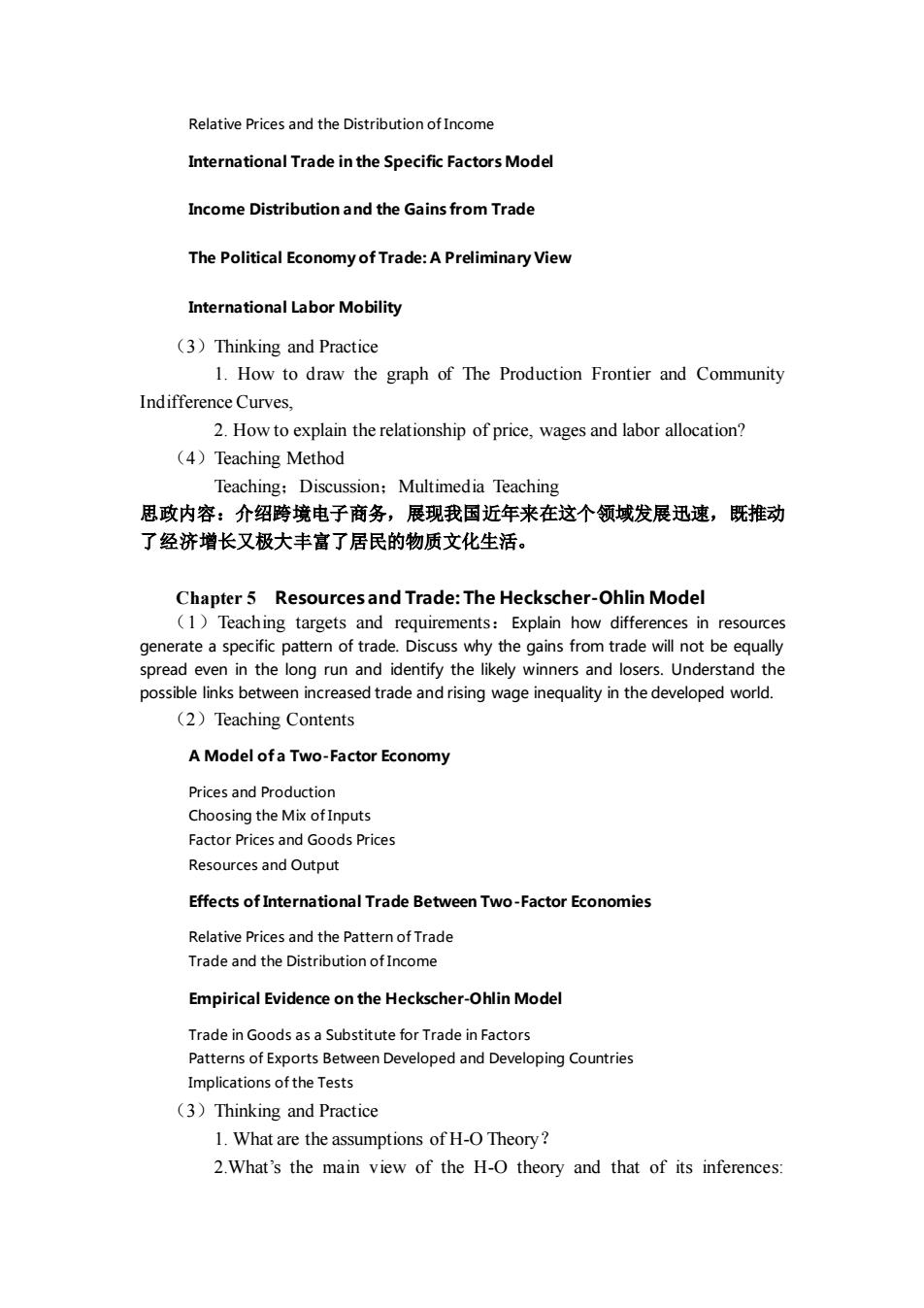
Relative Prices and the Distribution ofIncome International Trade in the Specific Factors Model Income Distribution and the Gains from Trade The Political Economy of Trade:A Preliminary View International Labor Mobility (3)Thinking and Practice 1.How to draw the graph of The Production Frontier and Community Indifference Curves, 2.How to explain the relationship of price,wages and labor allocation? (4)Teaching Method Teaching:Discussion:Multimedia Teaching 思政内容:介绍跨境电子商务,展现我国近年来在这个领域发展迅速,既推动 了经济增长又极大丰富了居民的物质文化生活。 Chapter 5 Resources and Trade:The Heckscher-Ohlin Model (1)Teaching targets and requirements:Explain how differences in resources generate a specific pattern of trade.Discuss why the gains from trade will not be equally spread even in the ong run and identify the likely w winners and losers.Understand the trade d rising wage inequality in the develope (2)Teaching Contents A Model ofa Two-Factor Economy fInputs Factor Prices and Goods Prices Resources and Output Effects of International Trade Between Two-Factor Economies Relative Prices and the Pattern of Trade Trade and the Distribution ofIncome Empirical Evidence on the Heckscher-Ohlin Model Trade in Goods as a Substitute for Trade in Factors of Exports Between Develope and Developing Countrie Implicationsof the Tests (3)Thinking and Practice 1.What are the assumptions of H-OTheory? 2.What's the main view of the H-O theory and that of its inferences:
Relative Prices and the Distribution of Income International Trade in the Specific Factors Model Income Distribution and the Gains from Trade The Political Economy of Trade: A Preliminary View International Labor Mobility (3)Thinking and Practice 1. How to draw the graph of The Production Frontier and Community Indifference Curves, 2. How to explain the relationship of price, wages and labor allocation? (4)Teaching Method Teaching;Discussion;Multimedia Teaching 思政内容:介绍跨境电子商务,展现我国近年来在这个领域发展迅速,既推动 了经济增长又极大丰富了居民的物质文化生活。 Chapter 5 Resources and Trade: The Heckscher-Ohlin Model (1)Teaching targets and requirements:Explain how differences in resources generate a specific pattern of trade. Discuss why the gains from trade will not be equally spread even in the long run and identify the likely winners and losers. Understand the possible links between increased trade and rising wage inequality in the developed world. (2)Teaching Contents A Model of a Two-Factor Economy Prices and Production Choosing the Mix of Inputs Factor Prices and Goods Prices Resources and Output Effects of International Trade Between Two-Factor Economies Relative Prices and the Pattern of Trade Trade and the Distribution of Income Empirical Evidence on the Heckscher-Ohlin Model Trade in Goods as a Substitute for Trade in Factors Patterns of Exports Between Developed and Developing Countries Implications of the Tests (3)Thinking and Practice 1. What are the assumptions of H-O Theory? 2.What’s the main view of the H-O theory and that of its inferences:
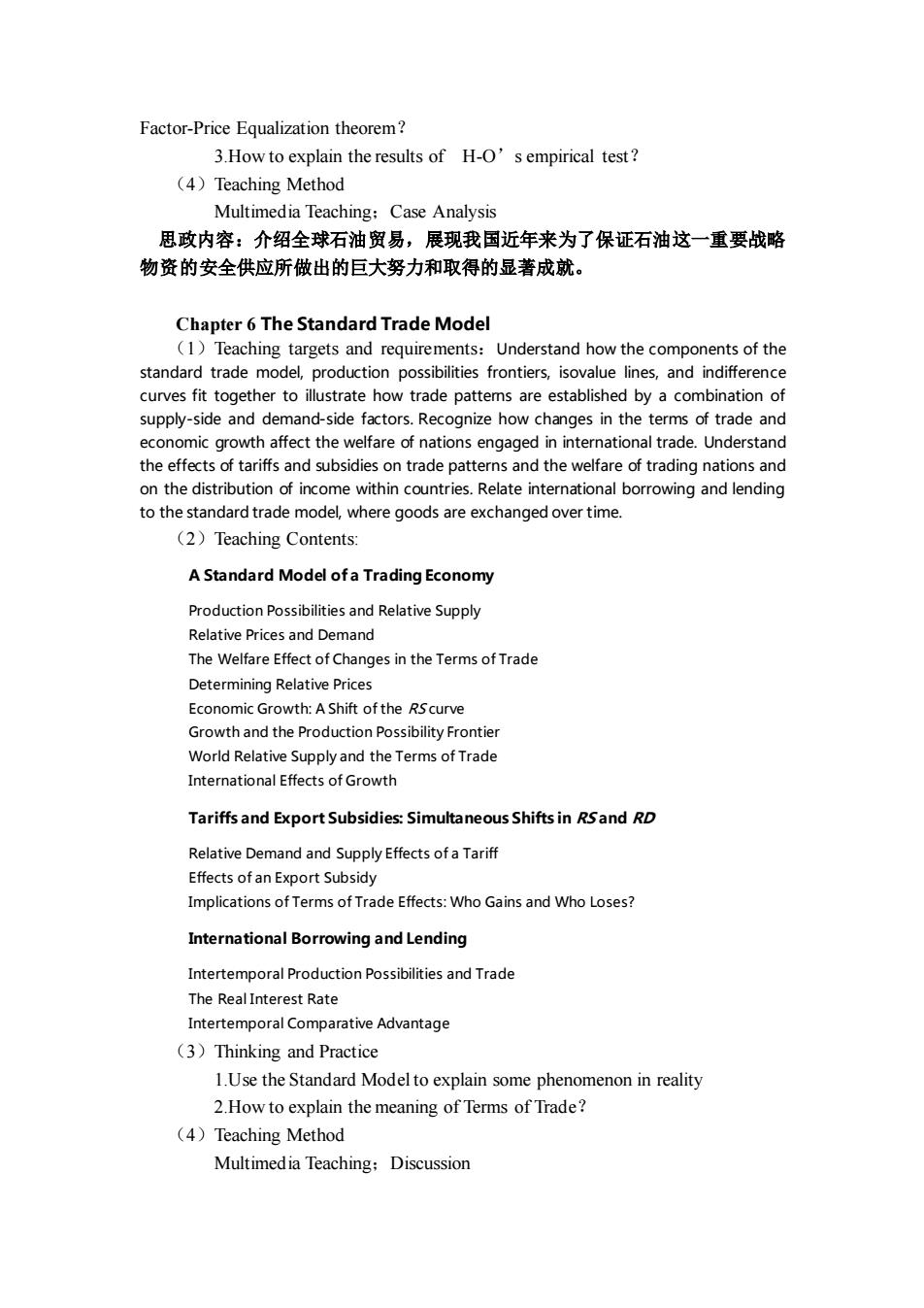
Factor-Price Equalization theorem? 3.How to explain the results of H-O's empirical test? (4)Teaching Method Multimedia Teaching:Case Analysis 思政内容:介绍全球石油贸易,展现我国近年来为了保证石油这一重要战略 物资的安全供应所做出的巨大努力和取得的显著成就。 Chapter 6 The Standard Trade Model 1)Tching arets andend ho the compents of th standard ade del pos curves fit ogether to trate how trade pattems are established by a combi supply-side and demand-side factors.R cognize how changes in the terms of trade and economic growth affect the welfare of nations engaged in international trade.Understand the effects of tariffs and subsidies on trade patterns and the welfare of trading nations and on the distribution of income within countries.Relate international borrowing and lending to the standard trade model,where goods are exchanged over time. (2)Teaching Contents A Standard Model ofa Trading Economy Production Possibilities and Relative Supply Relative Prices and demand The Welfare Effect of Changes in the Terms of Trade Determining Relative Prices Economic Growth:A Shift of the RScurve Growth and the Production Possibility Frontier World Relative Supply and the Terms of Trade International Effects of Growth Tariffs and Export Subsidies:Simultaneous Shifts in RSand RD Relative Demand and Supply Effects of a Tariff Effects of an Export Subsidy Implications of Terms of Trade Effects:Who Gains and Who Loses? International Borrowing and Lending Intertemporal Production Possibilities and Trade The RealInterest Rate Intertemporal Comparative Advantage (3)Thinking and Practice l Use the standard model to explain some phenomenon in reality 2.How to explain the meaning of Terms of Trade? (4)Teaching Method Multimedia Teaching:Discussion
Factor-Price Equalization theorem? 3.How to explain the results of H-O’s empirical test? (4)Teaching Method Multimedia Teaching;Case Analysis 思政内容:介绍全球石油贸易,展现我国近年来为了保证石油这一重要战略 物资的安全供应所做出的巨大努力和取得的显著成就。 Chapter 6 The Standard Trade Model (1)Teaching targets and requirements:Understand how the components of the standard trade model, production possibilities frontiers, isovalue lines, and indifference curves fit together to illustrate how trade patterns are established by a combination of supply-side and demand-side factors. Recognize how changes in the terms of trade and economic growth affect the welfare of nations engaged in international trade. Understand the effects of tariffs and subsidies on trade patterns and the welfare of trading nations and on the distribution of income within countries. Relate international borrowing and lending to the standard trade model, where goods are exchanged over time. (2)Teaching Contents: A Standard Model of a Trading Economy Production Possibilities and Relative Supply Relative Prices and Demand The Welfare Effect of Changes in the Terms of Trade Determining Relative Prices Economic Growth: A Shift of the RS curve Growth and the Production Possibility Frontier World Relative Supply and the Terms of Trade International Effects of Growth Tariffs and Export Subsidies: Simultaneous Shifts in RS and RD Relative Demand and Supply Effects of a Tariff Effects of an Export Subsidy Implications of Terms of Trade Effects: Who Gains and Who Loses? International Borrowing and Lending Intertemporal Production Possibilities and Trade The Real Interest Rate Intertemporal Comparative Advantage (3)Thinking and Practice 1.Use the Standard Model to explain some phenomenon in reality 2.How to explain the meaning of Terms of Trade? (4)Teaching Method Multimedia Teaching;Discussion
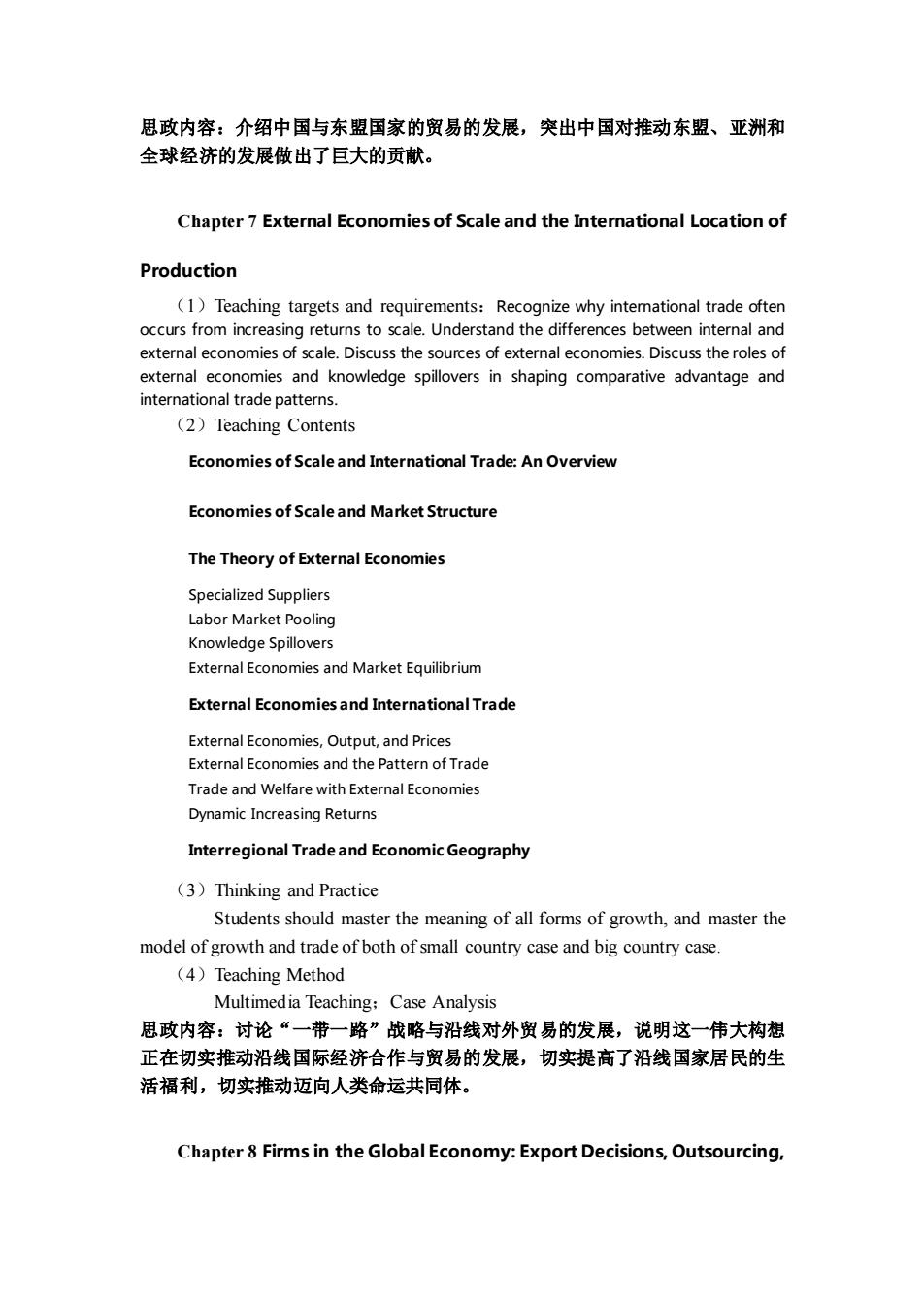
思政内容:介绍中国与东盟国家的贸易的发展,突出中国对推动东盟、亚洲和 全球经济的发展做出了巨大的贡献。 Chapter 7 External Economies of Scale and the International Location of Production (1Teaching targets and requirements:Recognize why interational trade ofter occurs from increasing returns to scale.Understand the differences between internal and external economies of scale.Discuss the sources of external economies.Discuss the roles o external economies and knowledge spillovers in shaping comparative advantage and international trade patterns. (2)Teaching Contents Economies of Scale and International Trade:An Overview Economies of Scale and Market Structure The Theory of External Economies Specialized Suppliers Labor Market Pooling Knowledge Spillovers External Economies and Market Equilibrium External Economies and InternationalTrade External Economies,Output,and Prices External Economies and the Pattern of Trade Trade and Welfare with External Economies Dynamic Increasing Returns Interregional Trade and Economic Geography (3)Thinking and Practice Students should master the meaning of all forms of growth,and master the model of growth and trade of both of small country case and big country case (4)Teaching Method Multimedia Teaching:Case analysis 思政内容:讨论“一带一路”战略与沿线对外贸易的发展,说明这一伟大构想 正在切实推动沿线国际经济合作与贸易的发展,切实提高了沿线国家居民的生 活福利,切实推动迈向人类命运共同体。 Chapter 8 Firms in the Global Economy:Export Decisions,Outsourcing
思政内容:介绍中国与东盟国家的贸易的发展,突出中国对推动东盟、亚洲和 全球经济的发展做出了巨大的贡献。 Chapter 7 External Economies of Scale and the International Location of Production (1)Teaching targets and requirements:Recognize why international trade often occurs from increasing returns to scale. Understand the differences between internal and external economies of scale. Discuss the sources of external economies. Discuss the roles of external economies and knowledge spillovers in shaping comparative advantage and international trade patterns. (2)Teaching Contents Economies of Scale and International Trade: An Overview Economies of Scale and Market Structure The Theory of External Economies Specialized Suppliers Labor Market Pooling Knowledge Spillovers External Economies and Market Equilibrium External Economies and International Trade External Economies, Output, and Prices External Economies and the Pattern of Trade Trade and Welfare with External Economies Dynamic Increasing Returns Interregional Trade and Economic Geography (3)Thinking and Practice Students should master the meaning of all forms of growth, and master the model of growth and trade of both of small country case and big country case. (4)Teaching Method Multimedia Teaching;Case Analysis 思政内容:讨论“一带一路”战略与沿线对外贸易的发展,说明这一伟大构想 正在切实推动沿线国际经济合作与贸易的发展,切实提高了沿线国家居民的生 活福利,切实推动迈向人类命运共同体。 Chapter 8 Firms in the Global Economy: Export Decisions, Outsourcing

and Multinational Enterprises entiation lead to international trade and intra-industry trade.Recognize the new types of welfare gains from intra-industry trade.Describe how economic integration can lead to both winners and losers among firms in the same industry.Explain why economists believe that "dumping"should not be singled out as an unfair trade practice,and why the enforcement of antidumping laws leads to protectionism.Explain why firms that engage in the global economy (exporters,outsourcers,multinationals)are substantially lar ger and perfomm better than firms that do not interact with foreign markets Understan h es that the of multinatio als an the o foreign direct investment across economies (2)Teaching Contents The Theory ofImperfect Competition Monopolistic Competition Monopolistic Competition and Trade The Effects ofIncreased Market Size Gains froman Integrated Market ANumerical Example The Significance ofI ntra -Industry Trade Firm Responses to Trade:Winners,Losers,and Industry Performance Performance Differences Across Producers The Effects ofIncreased Market Size Trade Costs and Export Decisions Dumping Multinationals and Outsourcing (3)Thinking and Practice Explain The Significance ofIntra-Industry Trade (4)Teaching Method Discussion:Multimedia Teaching 思政内容:举几个例子,关于我国的大型跨国公司的,说明我国的大型企业在 其他国家和地区在促进当地经济发展和承担社会责任方面十分突出。 Chapter 9 The Instruments of Trade Policv ing targets and requ rement: the costs and benefits of tariffs their welfaref ects,and winners and sers of tariff policies. scuss what export subs and agricultural subsidies are,and explain how they affect trade in agriculture in the Unite States and the European Union.Recognize the effect of voluntary export restraints(VERs)on
and Multinational Enterprises (1)Teaching targets and requirements:Understand how internal economies of scale and product differentiation lead to international trade and intra-industry trade. Recognize the new types of welfare gains from intra-industry trade. Describe how economic integration can lead to both winners and losers among firms in the same industry. Explain why economists believe that “dumping” should not be singled out as an unfair trade practice, and why the enforcement of antidumping laws leads to protectionism. Explain why firms that engage in the global economy (exporters, outsourcers, multinationals) are substantially larger and perform better than firms that do not interact with foreign markets. Understand theories that explain the existence of multinationals and the motivation for foreign direct investment across economies. (2)Teaching Contents The Theory of Imperfect Competition Monopoly: A Brief Review Monopolistic Competition Monopolistic Competition and Trade The Effects of Increased Market Size Gains from an Integrated Market: A Numerical Example The Significance of Intra-Industry Trade Firm Responses to Trade: Winners, Losers, and Industry Performance Performance Differences Across Producers The Effects of Increased Market Size Trade Costs and Export Decisions Dumping Multinationals and Outsourcing (3)Thinking and Practice Explain The Significance of Intra-Industry Trade (4)Teaching Method Discussion;Multimedia Teaching 思政内容:举几个例子,关于我国的大型跨国公司的,说明我国的大型企业在 其他国家和地区在促进当地经济发展和承担社会责任方面十分突出。 Chapter 9 The Instruments of Trade Policy (1)Teaching targets and requirements:Evaluate the costs and benefits of tariffs, their welfare effects, and winners and losers of tariff policies. Discuss what export subsidies and agricultural subsidies are, and explain how they affect trade in agriculture in the United States and the European Union. Recognize the effect of voluntary export restraints (VERs) on

both importing and exporting countries,and describe how the welfare effects of these VERs compare with tariff and quota policies. (2)Teaching Contents Basic Tariff Analysis Supply.Demand,and Trade in a Single Industry Effects of a Tariff Measuring the Amount of Protection Costs and Benefits of a Tariff Consumer and Producer Surplus Measuring the Costs and Benefits Other Instruments of Trade Policy Export Subsidies:Theory Import Quotas:Theory Voluntary Export Restraints Local Conten Other Trade Policy Instruments The Effects of Trade Policy:A Summary (3)Thinking and Practice 1.Master the Partial Equilibrium Analysis of a Tariff,and the General Equilibrium Analysis of a Tariff both in a small country and a large country. 2.How to choose a kind of non-tariff barriers in different situations? (4)Teaching Method Multimedia Teaching:Case Analysis 思政内容:讨论中美在贸易方面的冲突与协作,突出我国一贯谋求通过经济合 作与他国实现互利共赢。 Chapter 10 The Political Economy of Trade Policy (1 Teach zets and Articu argum nts for free trade that go Evaluate nati onal welfare arguments against free “political economy views or trade pollcy Explain how intemational negotiations and agreements have promoted world trade.Discuss the special issues raised by preferential trade agreements. (2)Teaching Contents The Case for Free Trade Free Trade and Efficiency Additional Gains from Free Trade Rent-Seeking Political Argument for Free Trade
both importing and exporting countries, and describe how the welfare effects of these VERs compare with tariff and quota policies. (2)Teaching Contents Basic Tariff Analysis Supply, Demand, and Trade in a Single Industry Effects of a Tariff Measuring the Amount of Protection Costs and Benefits of a Tariff Consumer and Producer Surplus Measuring the Costs and Benefits Other Instruments of Trade Policy Export Subsidies: Theory Import Quotas: Theory Voluntary Export Restraints Local Content Requirements Other Trade Policy Instruments The Effects of Trade Policy: A Summary (3)Thinking and Practice 1. Master the Partial Equilibrium Analysis of a Tariff, and the General Equilibrium Analysis of a Tariff both in a small country and a large country. 2. How to choose a kind of non-tariff barriers in different situations? (4)Teaching Method Multimedia Teaching;Case Analysis 思政内容:讨论中美在贸易方面的冲突与协作,突出我国一贯谋求通过经济合 作与他国实现互利共赢。 Chapter 10 The Political Economy of Trade Policy (1)Teaching targets and requirements:Articulate arguments for free trade that go beyond the conventional gains from trade. Evaluate national welfare arguments against free trade. Relate the theory and evidence behind “political economy” views of trade policy. Explain how international negotiations and agreements have promoted world trade. Discuss the special issues raised by preferential trade agreements. (2)Teaching Contents The Case for Free Trade Free Trade and Efficiency Additional Gains from Free Trade Rent-Seeking Political Argument for Free Trade
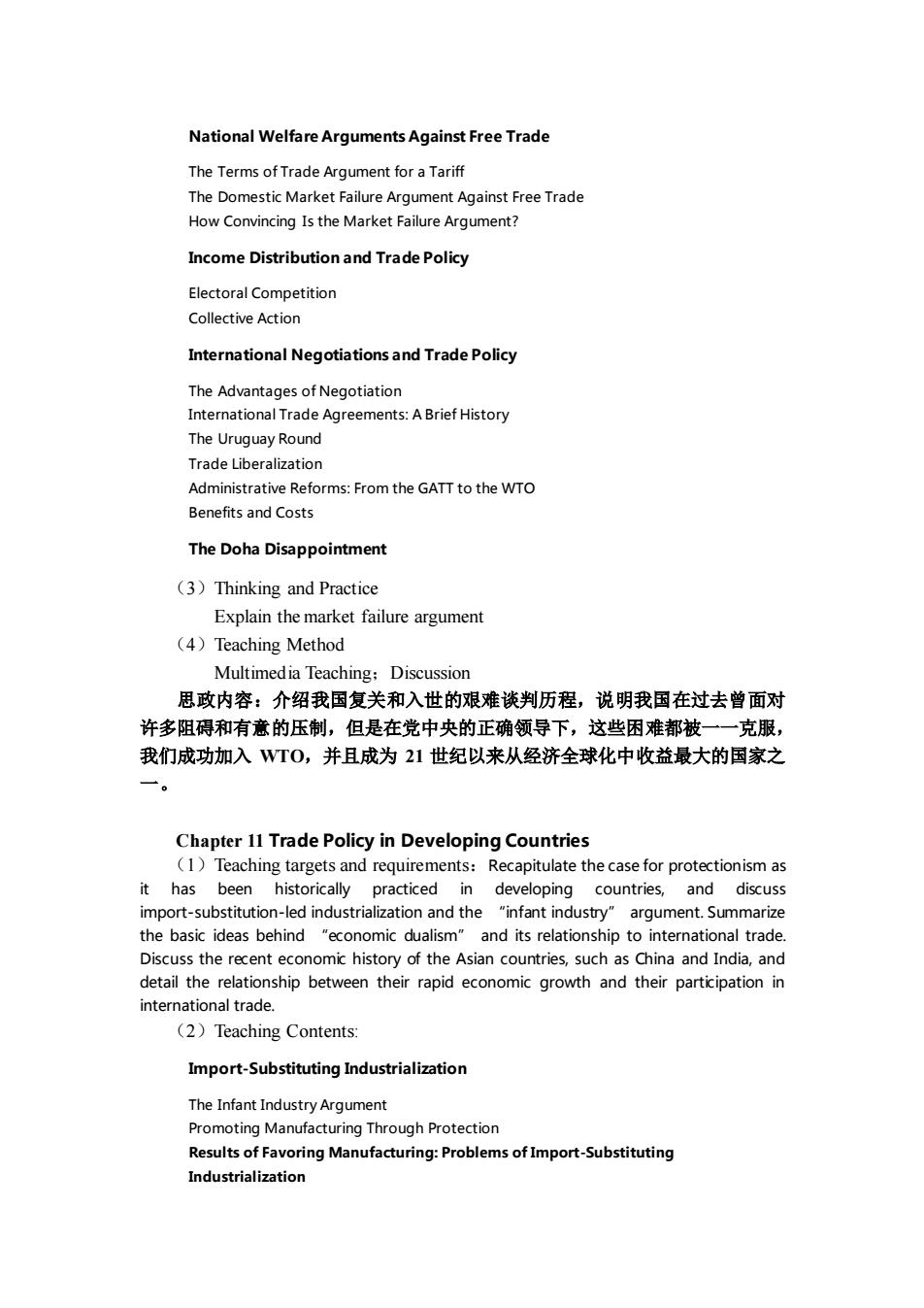
National Welfare Arguments Against Free Trade The Terms of Trade Argument fora Tariff The Marke r Trade How Convincing Is the Market Failure Argument? Income Distribution and Trade Policy Electoral Competition Collective Action International Negotiations and Trade Policy The Advantages of Negotiation International Trade Agreements:A Brief History The Uruguay Round Administrative Reforms:From the GATT to the WTO Benefits and Costs The Doha Disappointment (3)Thinking and Practice Explain the market failure argumen (4)Teaching Method Multimedia Teaching:Discussion 思政内容:介绍我国复关和入世的艰难谈判历程,说明我国在过去曾面对 许多阻碍和有意的压制,但是在党中央的正确领导下,这些困难都被一一克服, 我们成功加入WTO,并且成为21世纪以来从经济全球化中收益最大的国家之 Chapter 11 Trade Policy in Developing Countries (1)Teaching targets and requirements:Recapitulate the case for protectionism as it has been historically practiced in developing countries,and discuss import-substitution-led industrialization and the "infant industry"argument.Summarize the basic ideas behind "economic dualism"and its relationship to international trade as China and India,and detail the latio ship between economic growth and t atio (2)Teaching Contents: Import-Substituting Industrialization The Infant Industry Argume Promoting Manuf ing Through Protec Results of Favoring Manufacturing:Problems of Import-Substituting Industrialization
National Welfare Arguments Against Free Trade The Terms of Trade Argument for a Tariff The Domestic Market Failure Argument Against Free Trade How Convincing Is the Market Failure Argument? Income Distribution and Trade Policy Electoral Competition Collective Action International Negotiations and Trade Policy The Advantages of Negotiation International Trade Agreements: A Brief History The Uruguay Round Trade Liberalization Administrative Reforms: From the GATT to the WTO Benefits and Costs The Doha Disappointment (3)Thinking and Practice Explain the market failure argument (4)Teaching Method Multimedia Teaching;Discussion 思政内容:介绍我国复关和入世的艰难谈判历程,说明我国在过去曾面对 许多阻碍和有意的压制,但是在党中央的正确领导下,这些困难都被一一克服, 我们成功加入 WTO,并且成为 21 世纪以来从经济全球化中收益最大的国家之 一。 Chapter 11 Trade Policy in Developing Countries (1)Teaching targets and requirements:Recapitulate the case for protectionism as it has been historically practiced in developing countries, and discuss import-substitution-led industrialization and the “infant industry” argument. Summarize the basic ideas behind “economic dualism” and its relationship to international trade. Discuss the recent economic history of the Asian countries, such as China and India, and detail the relationship between their rapid economic growth and their participation in international trade. (2)Teaching Contents: Import-Substituting Industrialization The Infant Industry Argument Promoting Manufacturing Through Protection Results of Favoring Manufacturing: Problems of Import-Substituting Industrialization